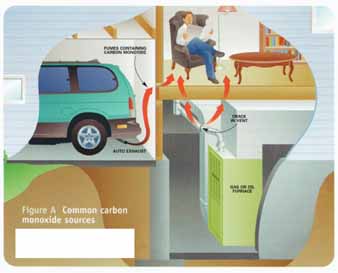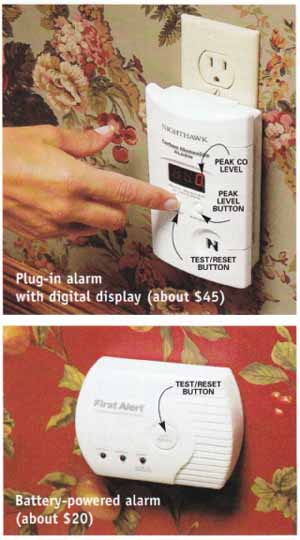Keep your energy-efficient home safe -- Follow these two steps to keep this silent killer at bay.

___ shows common CO sources. Carbon monoxide is produced
by oil- and wood-burning devices. Auto exhaust and poorly-vented furnaces
are the most dangerous sources in a home.
1. Install carbon monoxide (CO) alarms
What is CO?
CO is an invisible, odorless gas that’s produced by fire places, furnaces, stoves, water heaters and heaters that burn natural gas, propane, oil or wood. Usually chimneys and flues safely carry these combustion by-products up and out of your home. But not always. Flue blockage, poor natural drafting, leaks and other problems some times cause CO and other combustion gases to spill out into your living space and pollute the air you breathe (___ A). The CO is gradually absorbed into the blood stream. Light doses cause flulike symptoms, and larger doses lead to unconsciousness and death.
Cars, lawn mowers and snow blowers also produce a lot of CO, especially at start-up. If you have an attached garage, natural drafts tend to pull that CO into your home, even if you have the garage door open! As a rule, never let a car engine idle in a garage.
Is the CO threat greater in an energy-efficient home?
Sometimes. Reducing air leaks in your home is one of the best ways to make your home more energy efficient. Air tightening includes such things as closing up attic bypasses, weather-stripping, caulking around doors and windows, and installing new windows. But as your home gets tighter, flues and chimneys can’t vent CO and other combustion gases to the outside as easily, because they don’t have as much makeup air (see Step 2). CO alarms are simple, inexpensive insurance to warn you if CO spillage reaches a hazardous level ... even if your home is new or you haven’t taken steps to improve energy efficiency.
How dangerous is CO?
Accidental carbon monoxide (CO) poisoning accounts for several hundred deaths in the United States every year. The deaths are particularly tragic because most could have been easily prevented with a warning from a $20 to $45 CO alarm.
Where do I put the alarms?
At a minimum, put an alarm near the sleeping rooms on each level in your home. CO accumulates in the blood stream, and you’re most vulnerable during long periods of sleep. Position alarms on ceilings or walls, away from drafts and solvents. (Read the directions that come with each alarm for more details.)
What’s the best CO alarm to buy?
Look for a CO alarm with a UL (Underwriters Laboratories) listing on the package. It can be either battery-powered or a plug-in type (often with a battery backup; photos above). All alarms have a test/reset button that you should push weekly to make sure the alarm is operating.
We recommend the plug-in type with a digital readout that tells you the peak CO concentration whenever you push the peak level button. The CO level might not be high enough to trigger the alarm. But detecting a low level can alert you to a potential problem so you can trace the source before the CO reaches a higher level. This is particularly important if you have more vulnerable folks in your home such as young children, the elderly and those with certain illnesses.

Both types of CO alarms sound an alarm when hazardous levels
of CO are present. The type with a digital display will also show the
peak CO level in your home when you push the peak level button. It will
not record very low levels.
What should I do if an alarm goes off?
Here are general guidelines taken from the more detailed instructions that come with your alarm:
1. Push the test/reset button. (This is easier with a wall- mounted CO alarm.) 2. Call an emergency number, such as 911 or your fire department in most areas. 3. Go outside or move to a well-ventilated area, like next to an open window or door. Make sure all family members are accounted for. Wait for emergency services to arrive; they’ll make sure your house is well aired out. 4. If the alarm goes off again within 24 hours, follow steps 1 - 3 above and call in a qualified technician to test your fuel-burning equipment and find the problem. Be aware that furnace start-ups can set off the alarm under some conditions, as can starting cars in an attached garage.
WARNING: If an alarm sounds, you have a potentially lethal amount of CO in your home! Take the alarm seriously. Make every effort to find an explanation. You don’t want any level of CO in your home, much less a lethal level. Unfortunately, CO sources can be difficult to pin point. Don’t hesitate to call in a heating and ventilating technician experienced in CO issues to search out the probable causes and recommend corrections.
Also be aware of the symptoms of CO poisoning: slight headache, nausea, vomiting and fatigue (all flu-like symptoms) from mild exposures, and throbbing headache, drowsiness, confusion, fast heart rate or unconsciousness from heavier exposures.
2. Ask a heating service technician to conduct a complete backdrafting test at your annual heating equipment checkup
Backdrafting occurs when the combustion gases can’t go up and out flues and chimneys because outdoor air is already flowing down them (___ B). This often occurs when you run a clothes dryer, powerful range fan or any combination of venting fans. All suck air out of your home. If your house can’t get enough makeup air leaking in around windows and doors and through cracks and gaps in walls, the makeup air may come down the flues or chimney. Then your furnace, water heater or wood- burning fireplace may not vent properly, and combustion gases, including 00, will spill into your living space. (Studies have shown that backdrafting is common even in homes that are not energy efficient or airtight, so this test is worthwhile regardless of any energy-efficiency improvements you’ve made.)
A complete backdraft test only takes about 10 minutes. The service technician should close all doors and windows and turn on your ventilating fans, creating a worst-case situation. The technician will then turn on your water heater and test it for combustion gas spillage, and test the furnace as well.
If you have significant spillage, the technician should inspect your venting system and recommend solutions.

___ B Backdrafting: Backdrafting is a condition in which
air flows down a flue or chimney rather than up, and combustion fumes
can’t flow out. The fumes spilt into your living spaces.
Next: Permits, inspections and contractors